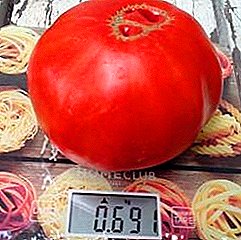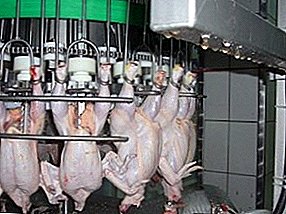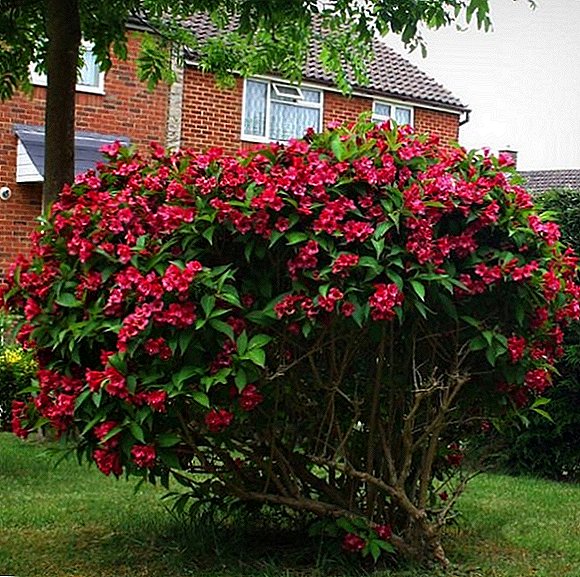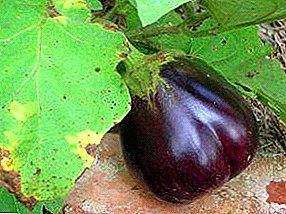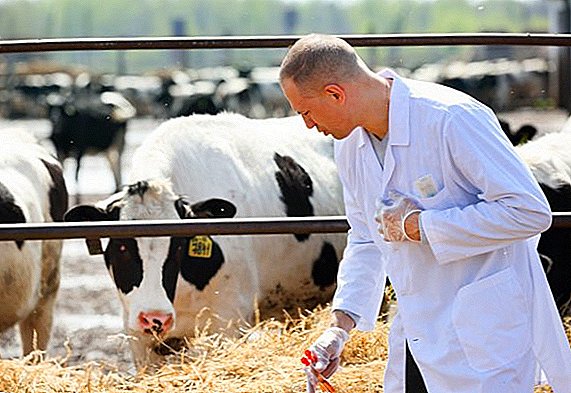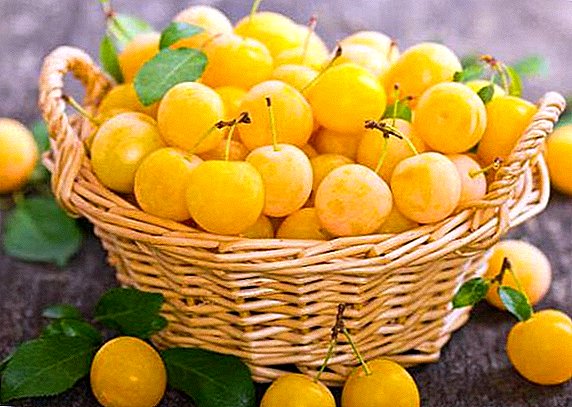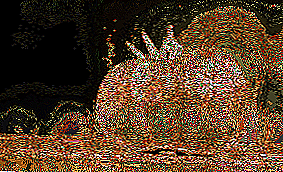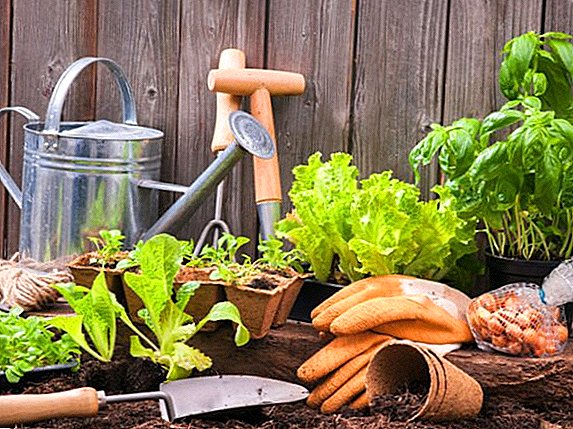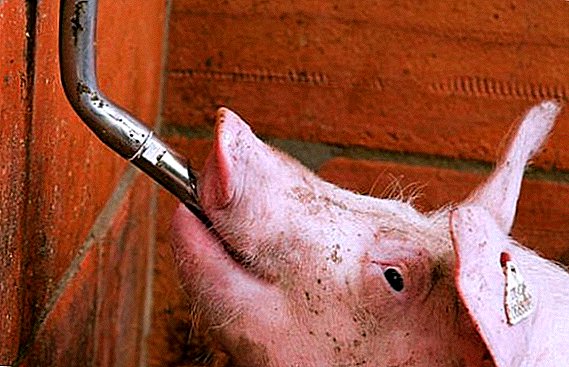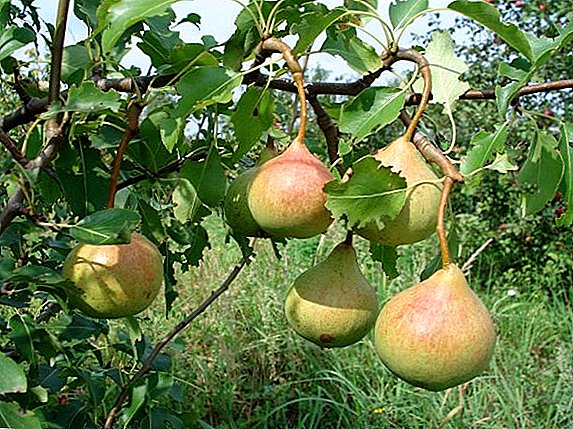 This article will discuss pear varieties. "Favorite Yakovlev". You will find all the necessary information that will help you to plant and grow this fruit tree.
This article will discuss pear varieties. "Favorite Yakovlev". You will find all the necessary information that will help you to plant and grow this fruit tree.
Pear "Favorite Yakovlev", general information
Before planting pears "Favorite Yakovlev" you need to read a brief description of the variety and get acquainted with interesting historical facts.
This variety was bred on the basis of the varieties Daughter Blancova and Bergamot. The variety was named after its discoverer - P. N. Yakovlev. After breeding, it was grown on an industrial scale. The “Favorite Yakovlev” is distributed in the Central, Central Black Earth and Middle Volga regions.
Did you know? The word "pear" in written sources is found from the XII century in the form of "pear". In the XYII century, instead of "pear" was used the word "dula" - the original of the Polish language.
Also, this type of pear is great for growing in the suburbs.
 The tree grows quickly, has a pyramidal crown shape, from which the branches extend at an angle of 90˚. The bark of the pear is gray. Fruits grow medium, smooth to the touch. At the time of ripening have a greenish-yellow color. (at consumer maturity - golden yellow with a slight tan). Fruit pulp has quince flavor, medium density and large stony cells.
The tree grows quickly, has a pyramidal crown shape, from which the branches extend at an angle of 90˚. The bark of the pear is gray. Fruits grow medium, smooth to the touch. At the time of ripening have a greenish-yellow color. (at consumer maturity - golden yellow with a slight tan). Fruit pulp has quince flavor, medium density and large stony cells.
Fruits pear "Favorite Yakovlev" designed for universal use and contain 8.2% of sugars and 8.4 mg of ascorbic acid. Consider the positive and negative sides of this variety.
The advantages include:
- high winter hardiness;
- good yield;
- excellent taste.
- rough fruit pulp;
- the presence of stony cells in the fruit;
- low self-fertility (in the role of pollinator use "Duchess summer").
Thus, the pear variety "Pet Yakovlev" has huge aboveground body, strong straight branches, gives a great harvest (about 20-25 kg from a tree), which ripens to the beginning of September.
Pear planting technology
 We have analyzed the specifics of the pear variety “Favorite Yakovlev”, now let's talk about planting and growing.
We have analyzed the specifics of the pear variety “Favorite Yakovlev”, now let's talk about planting and growing.
Deciding the question how to plant a pear "Favorite Yakovlev", need to read the basic rules. An improperly planted pear will give a meager crop or will not give it at all. Draft can bloom flowers, high humidity will cause decay, and the lack of light can cause plant disease.
Landing is carried out in the spring (in April) or fall (in October). The soil should have good drainage and fertility. The ideal option would be light loamy soils.
Important! If the seedling is planted in clay soil, then it must first be fertilized with peat, add river sand to improve drainage. These actions are carried out independently of preplant supplementation.
Choosing a landing site
To make the plant feel comfortable the place you need to choose a sunny, protected from the north wind. You can plant a tree on the south side, behind the house. At the same time take care of the necessary distance, otherwise the tree can spoil the foundation of the building.
Also pay attention to The groundwater, which should not lie too close to the surface. The soil at the site of planting should not be waterlogged, highly acidic or alkaline.. Choose subacid soils with a capacity of humus horizon of 20 cm or more.
Landing pattern
 Before planting, a pit is dug out with a diameter of 70 cm and a depth of 1 m. At the same time, the seedling should be buried in the ground strictly up to the root collar (therefore, adjust the depth of the pit depending on the seedling's root system). Rasthe standing between the plants in the row should be at least 5 m, the distance between the rows should be 6 meters. At the bottom of the hole pour 5 kg of humus or compost, 5-6 kg of river sand (coarse), 15 g of superphosphate and 350-400 g of dolomite flour.
Before planting, a pit is dug out with a diameter of 70 cm and a depth of 1 m. At the same time, the seedling should be buried in the ground strictly up to the root collar (therefore, adjust the depth of the pit depending on the seedling's root system). Rasthe standing between the plants in the row should be at least 5 m, the distance between the rows should be 6 meters. At the bottom of the hole pour 5 kg of humus or compost, 5-6 kg of river sand (coarse), 15 g of superphosphate and 350-400 g of dolomite flour.
We plant the tree and set the support peg (so that the young trunk does not begin to bend and deform). When planting, use fertile land. After the above actions, the pear is poured on 30 liters of water.
This is where the pears are planted. If the tree is poorly accepted, use warm water for irrigation.
How to water a pear
Having planted the pears of the “Favorite Yakovlev” in my garden, it’s important to know how to water the plant.
Sapling needs abundant watering during the growing season. This variety likes the method of rain irrigation (when moisture gets on the whole aboveground body, and only then comes to the roots). Given the size of an adult tree, it is impossible to conduct such watering, therefore, a shallow ditch with a diameter of 10-15 cm larger than the diameter of the trunk is dug around the plant. In the moat you need to pour in the morning or after sunset at least 25 liters of water.
Important! The older the tree, the more water is used for watering (a seven-year-old tree requires 30-33 liters of water).
Fertilizer pear "Favorite Yakovlev"
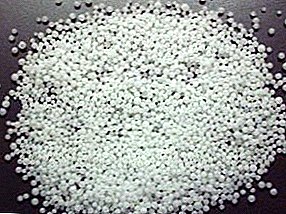 In the first 3 years, the young tree needs nitrogen fertilizers (50 kg per 1 ha). Half make before flowering, and half - two weeks after flowering.
In the first 3 years, the young tree needs nitrogen fertilizers (50 kg per 1 ha). Half make before flowering, and half - two weeks after flowering.
Important! If the tree grows poorly, the dose of nitrogen fertilizers can be increased.
In the summer, watering the pears is combined with dressings. In the form of fertilizer used organic infusions, mineral fertilizers, humus or compost.
To make the fruit better tied, fertilizers containing boron can be used. Bring them once before flowering or in the middle of it. If the frost-resistant pear is still frozen, then foliar dressing with 0.5% urea solution is carried out in several stages: the first - 2 weeks after flowering, the second - one week after the first.
Important! Older trees react differently to fertilizing. If you are not satisfied with the harvest, it is better to make a rejuvenating pruning than to “feed” the tree with humus and minerals.
Rules pruning pear "Pet Yakovlev"
Few gardeners know that correct pruning of a tree can yield much more than kilograms of fertilizer applied. In fact, pruning is not only rejuvenation and the correct formation of a tree, but also the removal of dry, sick and damaged branches that interfere with the plant.
Pear Pruning
 The trimming of an adult shaped tree consists in rejuvenation of branches, removal of sick and dry shoots, as well as in residual crown formation.
The trimming of an adult shaped tree consists in rejuvenation of branches, removal of sick and dry shoots, as well as in residual crown formation.
For the fourth and subsequent years, the crown of the pear is kept in size, which is determined by the planting system.
When pruning dry and diseased branches, some old shoots, on which there were no inflorescences, are subject to removal. The remaining branches are slightly shortened. This is done in order to limit growth and increase the formation of new buds.
When pruning need to remove branches that violate the general "system". The crown needs to be formed sparsely-tiered so that the density of the branches makes it easy to harvest. In this case, the lower tier of the shoots should be longer than the middle and upper.
Did you know? Gardeners have come up with a graft pear in the rowan. As a result, the hybrid turned out to be more unpretentious, but the fruits did not become so sweet and juicy, and the taste of pears gave a hint of rowan.
Pruning seedlings
To grow a beautiful fertile pear, you need to carry out the correct initial pruning of seedlings and saplings. When planting, all shoots are shortened by 1/3 of the total length. This is done to ensure that the tree is more acclimatized and acclimatized. The next pear pruning is carried out a year after planting, in March. Remove the top shoots, reducing the height of the tree to 90 cm.
In the second year, all lower branches must be removed to a height of 0.5 m, the "conductor" is cut to 35-40 cm from the upper side shoot of the lower tier.
 In the third year on the horizontal branches leave weaker shoots that will bear fruit (up to 30 cm long). Strong shoots of greater length are cut, leaving a few eyes at the base.
In the third year on the horizontal branches leave weaker shoots that will bear fruit (up to 30 cm long). Strong shoots of greater length are cut, leaving a few eyes at the base.
Important!"Favorite Yakovleva "needs to bend back the shoots to a horizontal position. When the branches reach a length of 15 cm, they are bent back using prishchepy. This work is carried out in May and June.
Harvesting and preserving fruits
At the beginning of the article we wrote about removable and consumer ripeness.
Harvest maturity is the degree of ripeness at which you want to remove the fruit for storage or for sale. Semi ripened fruits ripen indoors, and they are no different from ripened on the tree. This method allows you to extend the shelf life of the fruit is not to the detriment of its taste.
Consumer maturity - fully ripe fruit on the tree which has excellent taste, but does not persist for more than 2-3 weeks even in a cool place.
Therefore, harvesting is carried out depending on the intended use. The ideal option would be to collect 85-90% of greenish-yellow fruit and leave them for ripening and further storage, and the rest used for food after full ripening on the tree.
When the first fallen fruits appear, the degree of maturity must be monitored daily. To collect pears use bags with a detachable bottom.
 During harvesting, you need to sort the pears, It is imperative to exclude rotten, beaten or spoiled caterpillars.
During harvesting, you need to sort the pears, It is imperative to exclude rotten, beaten or spoiled caterpillars.
Cleaning is carried out only in dry weather, when there is no moisture on the fruits. After harvesting, you need to remove all the rotten fruit from the tree so that the pear does not hit the disease.
Did you know? Until Columbus brought tobacco to Europe, the inhabitants of the continent smoked the leaves of various plants, including pears. The leaves of this tree were the most popular.Now you are familiar with the pear "Favorite Yakovlev" and can not only by myself perform tree planting but also follow the rules of plant care, to keep it healthy and get a good harvest. This is a great variety of pears, which requires love and care from their owners, giving in return tasty and healthy fruits.


